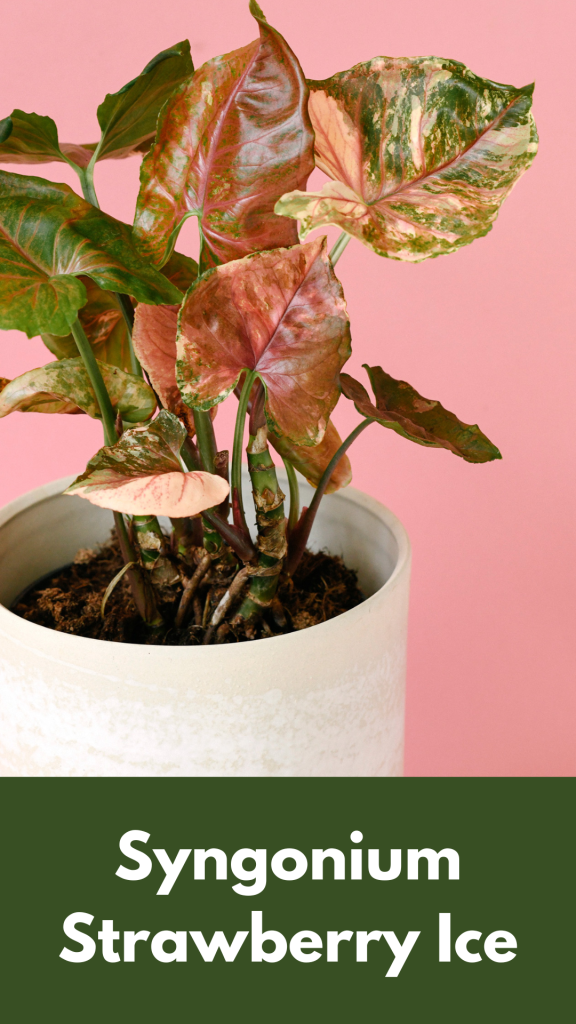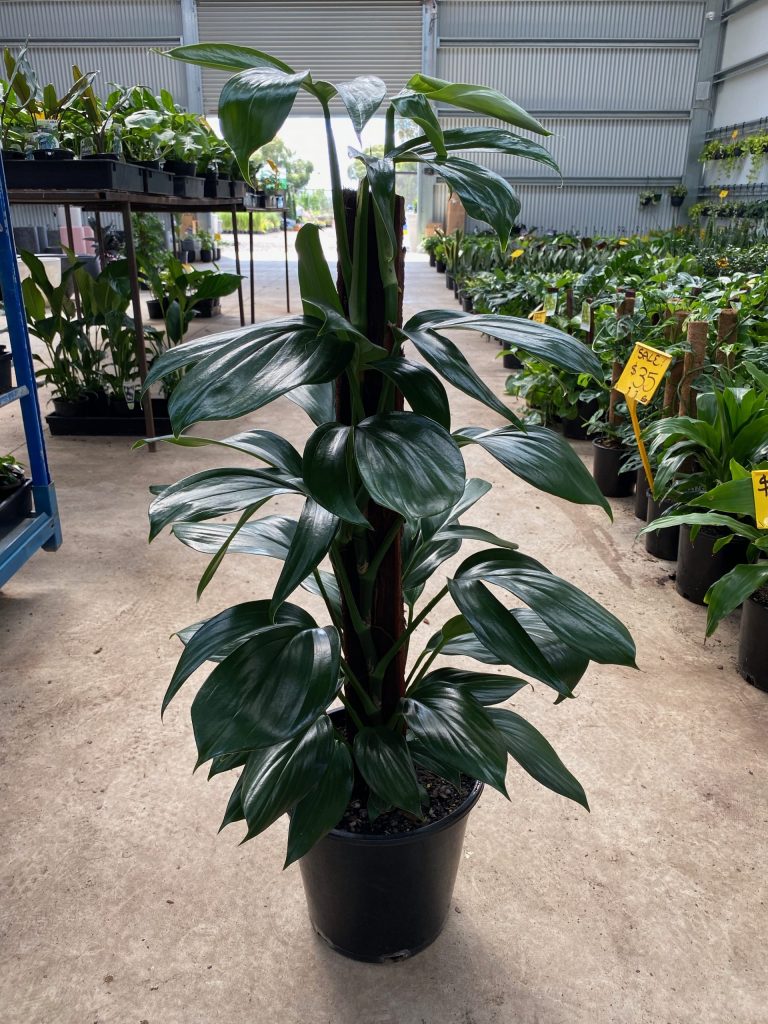Syngonium Strawberry Ice is a unique and eye-catching houseplant that is becoming increasingly popular among plant enthusiasts. This plant is a type of Syngonium, a genus of tropical plants native to Central and South America, and is a cultivar of Syngonium podophyllum. The name “Strawberry Ice” comes from its distinctive pink and white variegated leaves, which resemble the color of a strawberry sorbet.

Syngonium Strawberry Ice is a relatively easy plant to care for, making it a great option for both novice and experienced plant parents. It thrives in bright, indirect light but can also tolerate lower light conditions. It prefers to be kept slightly moist, but overwatering can lead to root rot, so it’s important to let the soil dry out partially between waterings. This plant is also sensitive to cold temperatures and should be kept in a warm and humid environment.
One of the unique features of Syngonium Strawberry Ice is its ability to change its leaf shape as it matures. When young, the leaves are arrow-shaped with a single point. However, as the plant grows and matures, the leaves become more complex and develop multiple lobes, resembling a “hand” or “fingers.”
In addition to its striking appearance, Syngonium Strawberry Ice also has air-purifying properties, making it a great addition to any indoor space. It is particularly effective at removing harmful toxins such as formaldehyde, benzene, and trichloroethylene from the air.
Botanical Classification of Syngonium Strawberry Ice
| Kingdom | Plantae |
| Clade | Angiosperms |
| Clade | Monocots |
| Order | Alismatales |
| Family | Araceae |
| Subfamily | Aroideae |
| Tribe | Caladieae |
| Genus | Syngonium |
| Species | Syngonium podophyllum |
| Cultivar | Syngonium podophyllum ‘Strawberry Ice’ |
Benefits of Syngonium Strawberry Ice
Syngonium Strawberry Ice is not only a beautiful houseplant, but it also offers several benefits to its human caretakers. Here are a few of them:
- Air Purification: One of the most significant benefits of Syngonium Strawberry Ice is its ability to purify the air in your home. This plant can filter out harmful toxins and pollutants, making the air you breathe cleaner and healthier. It can help reduce the risk of respiratory problems, allergies, and other health issues associated with poor indoor air quality.
- Aesthetic Appeal: Syngonium Strawberry Ice is an attractive plant with unique variegated leaves that can add a pop of color to any indoor space. Its pink and white leaves resemble a delicious strawberry sorbet and can be a conversation starter or an accent piece in your home decor.
- Mood-Boosting: Having plants in your home has been shown to have a positive impact on your mood and mental health. Caring for a plant like Syngonium Strawberry Ice can give you a sense of purpose and accomplishment and can help reduce stress and anxiety.
- Low Maintenance: Syngonium Strawberry Ice is an easy-to-care-for plant that doesn’t require much attention. It can tolerate a range of light conditions and only needs to be watered when the soil is partially dry. Its low maintenance nature makes it a great option for busy individuals or those new to plant parenting.
How to care for Syngonium Strawberry Ice
| Light Requirements | Low to Medium Light |
| Temperature Range | 60-85°F (15-29°C) |
| Watering | Allow soil to dry slightly between waterings |
| Humidity | Moderate to High |
| Soil Type | Well-draining, rich in organic matter |
| Fertilizer | Monthly during growing season |
| Pruning | Regularly to promote bushy growth |
| Propagation | Stem cuttings or division |
| Common Pests | Spider mites, mealybugs, scale insects |
| Common Problems | Overwatering, root rot, pest infestations |
| Toxicity | Toxic to pets and humans if ingested |
It’s important to note that while Syngonium Strawberry Ice can tolerate low light, it will thrive and produce more vibrant leaves with bright, indirect light. Additionally, it’s important to provide adequate humidity, either through a humidifier or regular misting, to prevent leaf browning and promote healthy growth.
Propagation Guide for Syngonium Strawberry Ice
Propagating Syngonium Strawberry Ice is a fun and easy way to expand your plant collection or share your love of plants with others. There are a couple of different ways you can do it, but the most common methods are stem cuttings or division.
To propagate using stem cuttings, you’ll need a healthy stem with at least two nodes. Cut the stem just below a node with a clean, sharp pair of scissors or a knife. If you want, you can dip the cut end of the stem in rooting hormone to help it along. Then, plant the cutting in a small pot with some well-draining soil and keep it moist and warm. You can cover the pot with a plastic bag or a dome to help it stay humid and encourage root growth. In a few weeks, you should start to see roots forming and new growth emerging.
If you’d rather propagate by division, gently remove the plant from its pot and carefully separate the roots into two or more sections. Make sure each section has at least one stem and a healthy root system. Then, plant each section in a separate pot with fresh soil and water them thoroughly. Keep the newly potted plants in a warm, humid location until they start to establish new growth.
Propagation can be done any time of the year, but it’s usually best to do it during the growing season for the best results. After you’ve propagated your new plants, keep them in a bright, indirect light and water them regularly to help them establish.
Commonly Asked Questions About Syngonium Strawberry Ice
Is Syngonium Strawberry Ice toxic to pets or humans?
Like many other plants, Syngonium Strawberry Ice can be toxic to pets and humans if ingested. The plant contains calcium oxalate crystals that can cause mouth irritation, difficulty swallowing, and even vomiting if ingested. It’s important to keep this plant out of reach of children and pets and to wash your hands after handling it.
How often should I water Syngonium Strawberry Ice?
Syngonium Strawberry Ice prefers consistently moist soil, but it’s important not to overwater it. Water the plant when the top inch of soil feels dry to the touch. Depending on the humidity and temperature of your home, this could mean watering every week or every few days.
Can I grow Syngonium Strawberry Ice in low light?
While Syngonium Strawberry Ice prefers bright, indirect light, it can tolerate lower light conditions. However, the plant may not grow as quickly or produce as much variegation in low light. If you notice the plant is not growing well, try moving it to a brighter location.
How often should I fertilize Syngonium Strawberry Ice?
Syngonium Strawberry Ice benefits from regular fertilization during the growing season (spring and summer). You can use a balanced fertilizer every 2-3 weeks, or a slow-release fertilizer every 2-3 months. It’s important not to over-fertilize, as this can cause salt buildup in the soil.
How can I encourage more variegation in Syngonium Strawberry Ice?
Variegation in Syngonium Strawberry Ice is affected by light levels. The more light the plant receives, the more variegation it will produce. You can also try cutting back on fertilizer, as too much nitrogen can cause the plant to produce less variegation. Finally, make sure the plant is getting enough humidity, as dry air can cause the variegation to fade.


